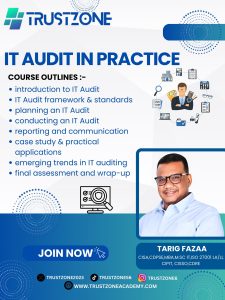An “IT Audit in practice” course focuses on providing practical knowledge and skills for conducting IT audits. These courses cover topics like IT governance, risk management, compliance, and security, often incorporating hands-on exercises and case studies to simulate real-world scenarios. They equip participants with the ability to assess IT systems, identify vulnerabilities, and recommend improvements to ensure compliance and mitigate risks.
Understanding the scope of IT audits, their purpose, and the different types of audits (e.g., security, compliance, operational).
Understanding the principles and practices of IT governance, including the role of IT in the organization, IT strategy, and risk management.
Identifying and assessing IT risks, implementing controls to mitigate them, and monitoring the effectiveness of those controls.
Understanding and adhering to relevant regulations and standards (e.g., SOX, HIPAA, PCI DSS).
Assessing the security of IT systems, identifying vulnerabilities, and recommending improvements to enhance security posture.
Understanding and testing IT general controls (ITGCs) and IT application controls (ITACs) to ensure the integrity and reliability of IT systems.
Developing audit plans, conducting audits, documenting findings, and making recommendations for improvement.
Understanding best practices in IT audit documentation and creating clear and concise audit reports.


Course Outline: IT Audit in Practice
Module 1: Introduction to IT Auditing
– Overview of IT Auditing
– Definition and importance
– Key objectives and benefits
Types of IT Audits
– Compliance audits
– Operational audits
– Financial audits
– Integrated audits
Module 2: IT Audit Frameworks and Standards
Common Frameworks
– COBIT
– ISO/IEC 27001
– NIST Cybersecurity Framework
Regulatory Requirements
– GDPR
– HIPAA
– SOX
Module 3: Planning an IT Audit
Audit Planning Process
– Establishing the audit scope and objectives
– Risk assessment and prioritization
Developing an Audit Plan
– Resource allocation
– Timelines and milestones?
Module 4: Conducting an IT Audit
Audit Methodologies
– Data collection techniques
– Interviewing stakeholders
– Document review
Testing and Evaluation
– Control testing
– Evidence collection
– Assessing compliance with policies and procedures
Module 5: Reporting and Communication
Audit Reporting
– Structure of an audit report
– Key findings and recommendations
Effective Communication
– Presenting findings to stakeholders
– Following up on audit recommendations
Module 6: Case Studies and Practical Applications
Real-world IT Audit Case Studies
– Analysis of successful audits
– Lessons learned from failures
Hands-on Exercises
– Simulated audit scenarios
– Role-playing exercises
Module 7: Emerging Trends in IT Auditing
Technology and IT Audit
– Impact of AI and machine learning
– Cybersecurity considerations
Future of IT Auditing
– Trends and challenges in the industry
Module 8: Final Assessment and Wrap-up
Capstone Project
– Conducting a mini-audit
– Presenting findings
Course Review and Feedback
– Summary of key concepts
– Course evaluation
Additional Resources
– Recommended readings and online resources
– Professional certifications in IT auditing (e.g., CISA, CISM)
This outline can be adjusted depending on the audience’s level of expertise and specific interests


